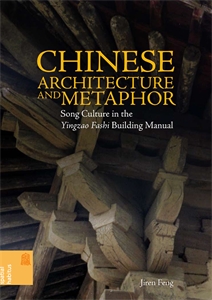Chinese Architecture and Metaphor: Song Culture in the Yingzao Fashi Building Manual
- About the Book
-
Investigating the historical tradition of Chinese architectural writing from antiquity to the twelfth century, Chinese Architecture and Metaphor reveals significant and fascinating social and cultural phenomena in the most important primary text for the study of the Chinese building tradition. Unlike previous scholarship, which has reviewed this imperially commissioned architectural manual largely as a technical work, this volume considers the Yingzao fashi’s unique literary value and explores the rich cultural implications in and behind its technical content.
Utilizing a philological approach, the author pays particular attention to the traditional and contemporary architectural terminology presented in the Yingzao fashi. In examining the semantic meaning of the architectural terms used in the manual, he uncovers a systematic architectural metaphor wherein bracketing elements are likened to flowers, flowering branches, and foliage: Thus pillars with bracketing above are compared to blossoming trees. More importantly, this intriguing imagery was shared by different social groups, in particular craftsmen and literati, and craftsmen themselves employed literary knowledge in naming architectural elements. Relating these phenomena to the unprecedented flourishing of literature, the literati’s greater admiration of technical knowledge, and the higher intellectual capacity of craftsmen during the Song, Architecture and Metaphor demonstrates how the learned and “unlearned” cultures entangled in the construction of architectural knowledge in premodern China. It convincingly shows that technical language served as a faithful carrier of contemporary popular culture and aesthetic concepts.
Chinese Architecture and Metaphor demonstrates a high level of engagement with a broad spectrum of sophisticated Chinese sources. It will become a classic work for all students and scholars of East Asian architecture.
- About the Author(s)
-
Jiren Feng, Author
Jiren Feng is assistant professor of Chinese at the University of Hawai‘i at Hilo.
- Reviews and Endorsements
-
- A new kind of analysis of the most famous work in the history of Chinese architecture, Jiren Feng’s book will be important for students of Chinese architecture, and useful for readers in pre-modern Chinese history, craft, and literature.
—BOOK NEWS - The result is a book with an overall framework highlighting architectural practice as an integral part of Song culture and, at the same time, introducing some key issues in the scholarship on YZFS, for instance, its terminology and relevant classical bibliography in sinology.
—China Review International - Feng has successfully shown how the Yingzao fashi, if explored in more detail, can allow new insights into Song society and culture. Overall this book is a great contribution to work on Chinese writings about architecture and to the understanding of the role of the Yongzao fashi in the Northern Song court."
—Tracy Miller, Vanderbilt University, Journal of Chinese Studies - This fascinating and erudite study takes a fresh and original approach to the most significant document in Chinese architectural history. Taking the terminology and textual strategies of the Yingzao fashi as his starting point, and drawing both on literature and on the structures and aesthetics of surviving buildings, Jiren Feng develops a complex and sophisticated cultural analysis of the text and of Chinese historical traditions of architectural writing more broadly, demonstrating that matter and metaphor cannot be disentangled in Chinese architectural thinking and practice. As well as being an argument about architecture, this is a study of poetics and of sensibilities, and a history of the meaning of grand buildings in Chinese cosmology and politics.
—Francesca Bray, University of Edinburgh - Yingzao fashi is a unique, illustrated treatise on how to construct premodern Chinese architecture. The text combines scholarly prose of the twelfth century and earlier, craftsmen’s jargon, both idiosyncratic and standardized solutions to structural issues of its day, and a host of allusions to Chinese art, architectural, and literary history. Jiren Feng’s original and convincingly argued book includes sensitive translations to large sections of the text and at the same time offers a new interpretation of the integral relation between traditional Chinese buildings and their symbolic language. This book will be read many times by every student of East Asian architecture.
—Nancy Steinhardt, University of Pennsylvania
- A new kind of analysis of the most famous work in the history of Chinese architecture, Jiren Feng’s book will be important for students of Chinese architecture, and useful for readers in pre-modern Chinese history, craft, and literature.
- Supporting Resources
-










